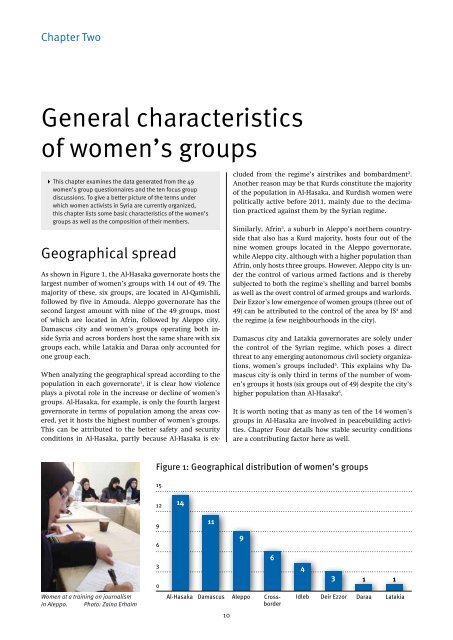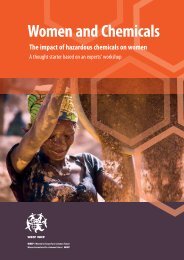future now”
YAO19
YAO19
You also want an ePaper? Increase the reach of your titles
YUMPU automatically turns print PDFs into web optimized ePapers that Google loves.
Chapter Two<br />
General characteristics<br />
of women’s groups<br />
4 This chapter examines the data generated from the 49<br />
women’s group questionnaires and the ten focus group<br />
discussions. To give a better picture of the terms under<br />
which women activists in Syria are currently organized,<br />
this chapter lists some basic characteristics of the women’s<br />
groups as well as the composition of their members.<br />
Geographical spread<br />
As shown in Figure 1, the Al-Hasaka governorate hosts the<br />
largest number of women’s groups with 14 out of 49. The<br />
majority of these, six groups, are located in Al-Qamishli,<br />
followed by five in Amouda. Aleppo governorate has the<br />
second largest amount with nine of the 49 groups, most<br />
of which are located in Afrin, followed by Aleppo city.<br />
Damascus city and women’s groups operating both inside<br />
Syria and across borders host the same share with six<br />
groups each, while Latakia and Daraa only accounted for<br />
one group each.<br />
When analyzing the geographical spread according to the<br />
population in each governorate 1 , it is clear how violence<br />
plays a pivotal role in the increase or decline of women’s<br />
groups. Al-Hasaka, for example, is only the fourth largest<br />
governorate in terms of population among the areas covered,<br />
yet it hosts the highest number of women’s groups.<br />
This can be attributed to the better safety and security<br />
conditions in Al-Hasaka, partly because Al-Hasaka is excluded<br />
from the regime’s airstrikes and bombardment 2 .<br />
Another reason may be that Kurds constitute the majority<br />
of the population in Al-Hasaka, and Kurdish women were<br />
politically active before 2011, mainly due to the decimation<br />
practiced against them by the Syrian regime.<br />
Similarly, Afrin 3 , a suburb in Aleppo’s northern countryside<br />
that also has a Kurd majority, hosts four out of the<br />
nine women groups located in the Aleppo governorate,<br />
while Aleppo city, although with a higher population than<br />
Afrin, only hosts three groups. However, Aleppo city is under<br />
the control of various armed factions and is thereby<br />
subjected to both the regime’s shelling and barrel bombs<br />
as well as the overt control of armed groups and warlords.<br />
Deir Ezzor’s low emergence of women groups (three out of<br />
49) can be attributed to the control of the area by IS 4 and<br />
the regime (a few neighbourhoods in the city).<br />
Damascus city and Latakia governorates are solely under<br />
the control of the Syrian regime, which poses a direct<br />
threat to any emerging autonomous civil society organizations,<br />
women’s groups included 5 . This explains why Damascus<br />
city is only third in terms of the number of women’s<br />
groups it hosts (six groups out of 49) despite the city’s<br />
higher population than Al-Hasaka 6 .<br />
It is worth noting that as many as ten of the 14 women’s<br />
groups in Al-Hasaka are involved in peacebuilding activities.<br />
Chapter Four details how stable security conditions<br />
are a contributing factor here as well.<br />
Figure 1: Geographical distribution of women’s groups<br />
15<br />
12<br />
14<br />
9<br />
6<br />
11<br />
9<br />
3<br />
0<br />
6<br />
4<br />
3 1 1<br />
Women at a training on journalism<br />
in Aleppo. Photo: Zaina Erhaim<br />
Al-Hasaka Damascus Aleppo Crossborder<br />
Idleb Deir Ezzor Daraa Latakia<br />
10



